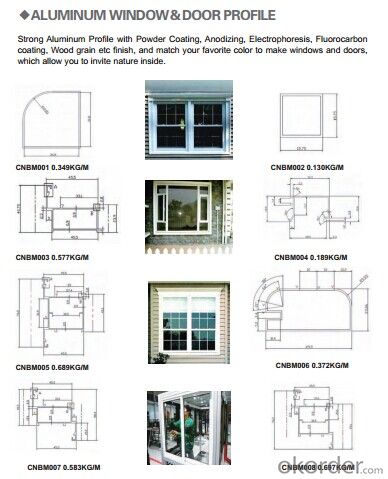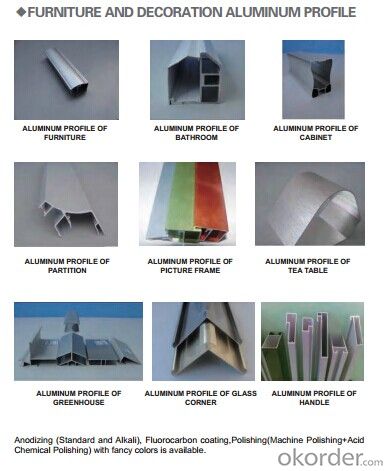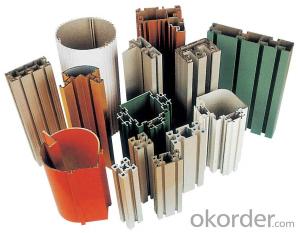Customized 6063 alu profile extrusion
- Loading Port:
- China Main Port
- Payment Terms:
- TT OR LC
- Min Order Qty:
- -
- Supply Capability:
- -
OKorder Service Pledge
OKorder Financial Service
You Might Also Like
Aluminium is a relatively soft, durable, lightweight, ductileand malleablemetalwith appearance ranging from silvery to dull gray, depending on the surfaceroughness. It is nonmagnetic and does not easily ignite. A fresh film ofaluminium serves as a good reflector (approximately 92%) of visible lightand an excellent reflector (as much as 98%) of medium and far infraredradiation. The yield strength of pure aluminium is 7–11 MPa,while aluminium alloys have yield strengths ranging from200 MPa to 600 MPa. Aluminium has about one-third the densityand stiffness of steel. It is easily machined,cast, drawn and extruded.
Aluminium alloys (or aluminum alloys; see spellingdifferences) are alloysin which aluminium(Al) is the predominant metal. The typical alloying elements are copper, magnesium,manganese,silicon,tin and zinc. There are twoprincipal classifications, namely casting alloys and wrought alloys, both of which are furthersubdivided into the categories heat-treatableand non-heat-treatable. About 85% of aluminium is used for wrought products,for example rolled plate, foils and extrusions.Cast aluminium alloys yield cost-effective products due to the low meltingpoint, although they generally have lower tensile strengthsthan wrought alloys. The most important cast aluminium alloy system is Al–Si,where the high levels of silicon (4.0–13%) contribute to give good castingcharacteristics. Aluminium alloys are widely used in engineering structures andcomponents where light weight or corrosion resistance is required
Features:
Material | Alloy 6063,6061,6005or according to customer’s choice |
Temper | T3, T4, T5, T6 |
Surface | Anodize, electrophoresis, powder coating, PVDF coating, wood grain painting, matted, etc. |
Length | Coating 6.5 meters, Anodizing 6.5 meters, Mill finish 5 meters |
Application | Industrial, electrical equipment(TV set, air conditioner, refrigerator, computer), decoration,construction, transportation |
Custom Made | We can package following with customer's request. |




FAQ:
1. What is the form of payment?
Normally 30% TT, L/C at sight
2. Type of quotation?
FOB, CFR, CIF
3. Port of loading?
Shenzhen/Guangzhou port
4. Delivery time?
15-20 days after client’s deposit
- Q:Are aluminum profiles suitable for use in the renewable energy industry?
- Aluminum profiles are well-suited for the renewable energy sector, offering numerous benefits. To begin with, aluminum is a versatile and lightweight material, making it ideal for renewable energy applications. The corrosion resistance of aluminum profiles is exceptional, allowing them to withstand outdoor conditions and moisture exposure. This durability ensures the longevity and structural integrity of the profiles. Moreover, the recyclability of aluminum profiles makes them an environmentally friendly choice for the renewable energy industry. With the industry's focus on reducing carbon footprint and promoting sustainability, aluminum's recyclability plays a crucial role in achieving these objectives. Aluminum can be recycled repeatedly without losing its essential properties, reducing the necessity for extracting and processing new raw materials. Another advantage of aluminum profiles is their design flexibility, enabling the creation of intricate shapes and structures tailored to specific requirements. This versatility makes them suitable for various renewable energy applications, including solar panel frames, wind turbine components, and mounting systems. Additionally, the lightweight nature of aluminum profiles simplifies transportation and installation processes, resulting in cost and energy savings. In conclusion, the corrosion resistance, recyclability, design flexibility, and lightweight properties make aluminum profiles an excellent choice for the renewable energy industry. These characteristics contribute to the efficiency, durability, and sustainability of renewable energy systems, establishing aluminum profiles as a fitting material for this sector.
- Q:What is the composition of aluminum profiles?
- Aluminum profiles are primarily composed of aluminum, which is a lightweight and highly malleable metal. They may also contain small amounts of other elements such as copper, magnesium, silicon, and zinc, depending on the specific alloy used. These additional elements are added to enhance the strength, durability, and other desired properties of the aluminum profiles.
- Q:Are aluminum profiles suitable for automotive body panels?
- Yes, aluminum profiles are suitable for automotive body panels. Aluminum is a lightweight and strong material, making it ideal for improving fuel efficiency and enhancing overall vehicle performance. Additionally, aluminum profiles offer excellent corrosion resistance, durability, and design flexibility, making them a popular choice for modern automotive applications.
- Q:The aluminum and Fenglv aluminum material which is better suited for doors and windows
- Al Feng is one of the ten famous material, certainly no problem. But Feng packaging is too thick, high cost. To do the doors and windows of the aluminum used to choose cost-effective, as a special material for the sale of aluminum, I have the following recommendations: 1. The window wheel is good, and the pressed glass should be durable and corrosion resistant. 2. doors and windows sealing performance better, 3. pages to be matched with materials, gauze or rust, and thickness and density better than 4. The cost performance is high, the surface treatment layer of the profile is electrophoresis, and the electrophoresis layer should be thick. 5. The mounting frame needs to be hit to the horizontal line.
- Q:What are the different methods of joining aluminum profiles together?
- There are several methods of joining aluminum profiles together, depending on the specific application and desired outcome. Some of the most common methods include: 1. Mechanical fastening: This method involves using screws, bolts, or rivets to secure the aluminum profiles together. It is a simple and cost-effective method, suitable for various applications. However, it may leave visible fasteners and require additional finishing. 2. Welding: Aluminum profiles can be joined through various welding techniques, such as TIG (Tungsten Inert Gas), MIG (Metal Inert Gas), or laser welding. Welding provides a strong and seamless joint, making it suitable for structural applications. However, it requires specialized equipment and expertise. 3. Adhesive bonding: Adhesives specifically designed for aluminum bonding can be used to join profiles together. This method offers high strength, uniform distribution of stress, and a clean aesthetic appearance. Adhesive bonding is commonly used for lightweight applications or when welding is not feasible. 4. Slotting and interlocking: Aluminum profiles with specially designed slots or interlocking features can be joined together without the need for additional hardware. This method provides a clean and seamless appearance while maintaining structural integrity. 5. Thermal joining: Heat-based methods such as hot plate welding or induction heating can be used to join aluminum profiles. These processes involve melting a portion of the aluminum surface and bonding it together upon cooling. Thermal joining offers high strength and aesthetics without the need for additional materials. 6. Extrusion-based connectors: Extrusion connectors are specially designed components that allow aluminum profiles to be joined together. These connectors are typically inserted into the profile's slots or channels, providing a secure and durable connection. It is important to consider factors such as strength requirements, appearance, ease of assembly, and cost when selecting the appropriate method for joining aluminum profiles. Each method has its advantages and limitations, so choosing the most suitable method depends on the specific application and desired outcome.
- Q:Fenglv aluminum material how ah? What aluminum materials do you use for windows and doors?
- Domestic aluminum quality is about the same, mainly you installed in the window accessories, is the key to the life of the service, recommend several brands Bar Reid Jan Ron Lixin spring is not recommended, quality is not very rely on live
- Q:T6 should be 140MPa, while the aluminum profile specification should be 150MPa. Should that be the standard?Code for design of glass curtain wall... And the calculation formula of bolt connection, what is the compressive strength value of aluminum profile?Prawns help you, 3Q~
- In this case, not only is the bending deformation produced by tensile stress, it is a large part of the moment and shear, in a large error.
- Q:What are the standard dimensions and sizes of aluminum profiles?
- The standard dimensions and sizes of aluminum profiles can vary depending on the specific application and industry. However, common sizes for aluminum profiles range from small profiles with dimensions around 10mm x 10mm to larger profiles with dimensions around 100mm x 100mm. Additionally, the length of aluminum profiles can vary but is often available in standard lengths of 2 meters, 3 meters, or 6 meters. It is important to consult the manufacturer or supplier for the specific dimensions and sizes required for a particular project.
- Q:Are aluminum profiles suitable for use in the defense industry?
- Yes, aluminum profiles are suitable for use in the defense industry. Aluminum is a lightweight, yet strong material that offers excellent corrosion resistance and high durability. It is commonly used in the defense industry for applications such as military vehicles, aircraft structures, and weapon systems. Additionally, aluminum profiles can be easily customized and fabricated to meet specific requirements, making them a versatile choice for defense applications.
- Q:Are aluminum profiles suitable for electrical conductivity applications?
- No, aluminum profiles are not suitable for electrical conductivity applications. While aluminum is a good conductor of electricity, aluminum profiles often have an oxide layer on their surface, which can hinder electrical conductivity. Additionally, aluminum profiles are prone to corrosion, which can further impact their conductivity. Therefore, materials with better conductivity properties such as copper or silver are usually preferred for electrical conductivity applications.
1. Manufacturer Overview |
|
|---|---|
| Location | |
| Year Established | |
| Annual Output Value | |
| Main Markets | |
| Company Certifications | |
2. Manufacturer Certificates |
|
|---|---|
| a) Certification Name | |
| Range | |
| Reference | |
| Validity Period | |
3. Manufacturer Capability |
|
|---|---|
| a)Trade Capacity | |
| Nearest Port | |
| Export Percentage | |
| No.of Employees in Trade Department | |
| Language Spoken: | |
| b)Factory Information | |
| Factory Size: | |
| No. of Production Lines | |
| Contract Manufacturing | |
| Product Price Range | |
Send your message to us
Customized 6063 alu profile extrusion
- Loading Port:
- China Main Port
- Payment Terms:
- TT OR LC
- Min Order Qty:
- -
- Supply Capability:
- -
OKorder Service Pledge
OKorder Financial Service
Similar products
New products
Hot products
Related keywords




























